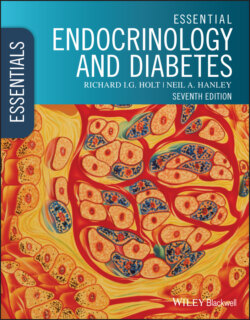Читать книгу Essential Endocrinology and Diabetes - Richard I. G. Holt - Страница 69
Box 3.6 Defects in growth hormone signalling pathways and growth hormone resistance syndromes
ОглавлениеSevere resistance to GH, mainly secondary to mutations in the GH receptor that commonly affect the hormone‐binding domain, is characterized by grossly impaired growth and is termed Laron syndrome, eponymously named after it was first reported by Laron in 1966 (Figure 3.9).It is an autosomal recessive disorder with a variable phenotype typified by normal or raised circulating GH and low levels of serum IGF‐I.
For other patients, no GHR mutations have been identified, implicating genes that encode downstream components or related aspects of GH signalling.For instance, defects in the IGF‐I gene have been associated with severe intrauterine growth retardation, mild mental retardation, sensorineural deafness and postnatal growth failure.
Figure 3.9 Laron syndrome showing truncal obesity. This boy presented aged 10.4 years but with a height of 95 cm – equivalent to that of a 3‐year‐old. In addition to truncal obesity, there is a very small penis. These features could represent severe growth hormone (GH) deficiency. However, serum GH levels were elevated with undetectable insulin‐like growth factor I (IGF‐I) indicative of GH resistance. Laron syndrome was diagnosed due to an inactivating mutation of the gene encoding the GH receptor. Other clinical features include a prominent forehead, depressed nasal bridge and under‐development of the mandible.
The most striking structural feature of all these receptors is the transmembrane domain comprised of hydrophobic helices, which cross the lipid bilayer of the plasma membrane seven times (Figure 3.10). GPCR signalling involves the hydrolysis of GTP to GDP. In their resting state, the G‐proteins exist in the cell membrane as heterotrimeric complexes of α, β and γ subunits. The β and γ subunits associate with high affinity, creating functional units of Gα and Gβ/γ. Hormone occupancy results in a conformational change in the receptor. In turn, this causes a conformational change in the α‐subunit, leading to an exchange of GDP for GTP. The acquisition of GTP causes the α‐subunit to dissociate from the Gβ/γ subunits and bind to a downstream catalytic unit, either adenylate cyclase in the generation of cAMP or phospholipase C (PLC) to produce DAG/IP3 from phosphatidylinositol (Figures 3.10 and 3.11). The energy to activate these target enzymes comes from the cleavage of one phosphate from GTP. This regenerates Gα‐GDP, which no longer associates with adenylate cyclase or PLC, thus switching off the cascade and recycling the Gα‐GDP back to the start.
There are over 20 isoforms of the Gα subunit that can be grouped into four major subfamilies (Box 3.7). These are differentially involved with different hormone receptor signalling pathways (Table 3.1). More than half of GPCRs can interact with different Gα subunits providing contrasting, and sometimes opposing, intracellular second messenger systems (Figure 3.12). In part, this promiscuity can be attributed to the extent of hormonal stimulation or according to the activation of different receptor subtypes. For instance, at low concentrations, TSH, calcitonin and LH receptors associate with Gsα to activate adenylate cyclase, whereas higher concentrations recruit Gqα to activate PLC. Calcitonin receptor subtypes are differentially expressed according to the stage of the cell cycle. Defects in the G‐protein signalling pathways result in many endocrine disorders (Box 3.8; Figures 3.13 and 3.14).
Figure 3.10 G‐protein–coupled receptors. The extracellular domain is ligand‐specific and, hence, less conserved across family members (e.g. only 35–45% for the TSH, LH and FSH receptors). The transmembrane domain has a characteristic heptahelical structure, most of which is embedded in the cell membrane and provides a hydrophobic core. Conserved cysteine residues can form a disulphide bridge between the second and third extracellular loops. The cytoplasmic domain links the receptor to the signal‐transducing G‐proteins and, in this example, is linked to membrane‐bound adenylate cyclase. The activation of adenylate cyclase is depicted by the conversion of C to C*.
Figure 3.11 Second messengers that mediate G‐protein–coupled receptor signalling. The symbol P is the abbreviation for a phosphate group. Carbon atoms are numbered in their ring position. R1 and R2 represent fatty acid chains.
